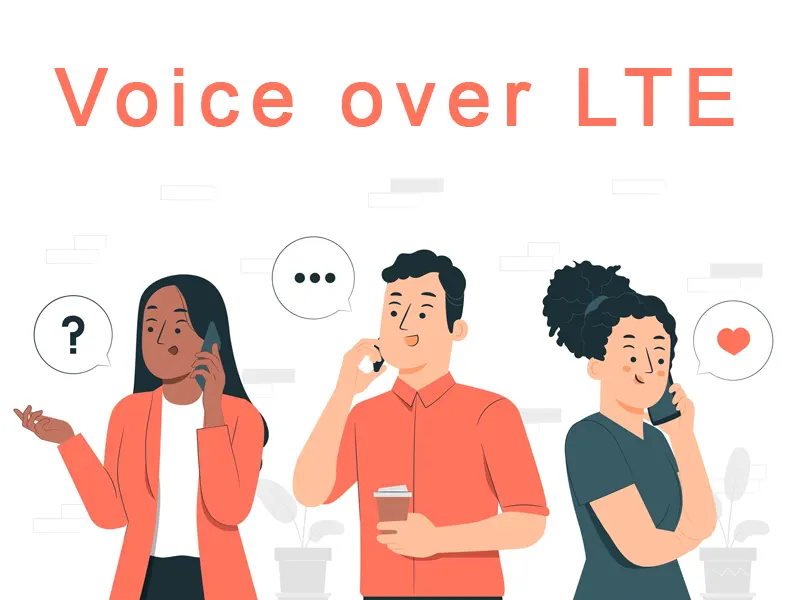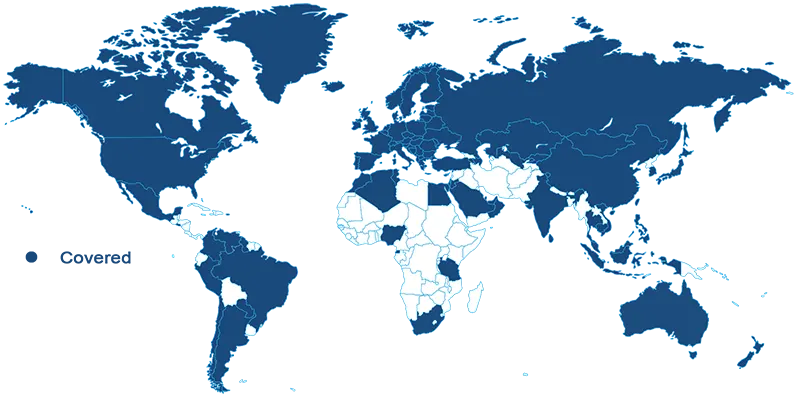VoLTE - An Evolution in Voice Communication
By now we’ve had 5 generations in mobile telecommunication networks. It all started with the First Generation Mobile Network emerging in Japan.
Technologies such as Advanced Mobile Phone Systems (AMPS) and Frequency Division Multiple Access (FDMA) made the first generation of wireless voice communication possible.
The next two generations introduced mobile internet to users and improved its capabilities. However, progress in terms of wireless communication’s core utility, i.e. voice communication remained stagnant.
It wasn’t until the introduction of 4G LTE that we got a big upgrade in terms of voice communication. The upgrade was VoLTE.
We’re going to discuss VoLTE in detail in this blog and understand how it works and what improvements it got us.
Let’s begin now, shall we?
What is Voice over Long Term Evolution (VoLTE)?

VoLTE is based on the IP Multimedia Subsystem (IMS) architectural framework and enables VoIP communication over the wireless LTE network.
Instead of a traditional voice stream over a GSM network, VoLTE delivers voice in the form of digital data packets over IP via an LTE network.
The benefit? A big upgrade in terms of voice quality, user experience and call stability.
The growing data transfer capabilities of 3G had many interested in implementing VoIP communication using mobile networks. The only hurdle was that 3G was too slow and suffered from high latency.
This meant the 3G wireless networks were not suitable and reliable enough to host a VoIP call between two parties.
However, VoIP over wireless networks became possible with the introduction of 4G LTE networks. The first commercial VoLTE service was launched in Dallas, Texas in 2012. It wasn’t until 2014 though, that VoLTE became a mainstay globally.
Now that you know what VoLTE is we can move on to understanding how it works.
How does VoLTE work?
The concept itself might seem very simple. After all, it's just a VoIP call over the LTE network right? However, VoLTE is far more complicated. There are a lot of things happening in the background to make a VoIP call over LTE possible.
We’ll break down the entire process into steps for a better understanding.
Step one - The caller places a call
A user may dial a number or place a call to one of his contacts. The moment he does that, the phone connects to the nearest cellphone tower on the LTE frequencies.
As it's a VoLTE call, the call request is transferred in the form of a data packet over IP. The cell tower receives the call and begins processing it.
Step two - Cellular Tower processes your call
The cellular tower checks the data packet and acquires all the necessary information to process the call. As with every VoIP-based communication, VoLTE makes use of the Session Initiation Protocol to connect the caller to the intended call recipient.
SIP in itself is an important protocol that enables IP-based communication. While it sounds simple, it involves multiple steps to establish a connection for a VoLTE call.
Step three - Your Call is connected over IP
SIP works its magic and establishes a direct line of communication between the caller and the intended call recipient. The call recipient’s phone is now ringing and the caller has to wait for them to answer their phone.
Step four - Your Call is answered
The intended caller answers their phone and now the bidirectional transfer of voice data can begin. Before VoLTE, voice data was in the form of an analog audio stream and required dedicated channels to make a voice call possible.
In VoLTE, the voice data is transferred in the form of data packets over the internet. This leads to a better user experience and higher audio quality.
For telecom operators, this capability means they can handle more calls through every telecom tower they have.
With this, you know how VoLTE works. We will now move on to understanding the benefits of VoLTE.
Top 5 Benefits of VoLTE
While there are many technical benefits of VoLTE, we’ll only look at the benefits the end consumers benefit the most out of.
Superior Call Quality
Technologies such as 2G and 3G allow seamless calls but lack tremendously in terms of audio quality. This in part is because of the data transmission throughput capabilities of the two mentioned technologies.
4G on the other hand is capable of 3X and 6X data throughput compared to 3G and 2G respectively. Being able to transmit more data translates into higher audio quality.
Moreover, the connections are more stable compared to legacy ones as they are based on IP. These improvements result in far superior call quality and user experience.
Improved Battery Life
Calling without VoLTE enabled means your smartphone will switch from the 4G network to 3G or 2G to make the call. Once the call is complete, your smartphone needs to reestablish the connection with the 4G network.

Thus, this switching process drains the battery due to the additional workload. As the 4G network is not optimized for direct voice calls, there is no way around this but VoLTE. But once you enable VoLTE, your battery consumption drops significantly.
There are claims that battery life should improve by almost 50%. However, users haven’t reported such gains and some have even countered the claims based on their experience.
Improved Coverage and Better Connectivity
Remember the old days when we had to walk outside to make calls? Or how you’d lose connectivity while in your bedroom? Connectivity was a concern when it came to 2G and 3G technology. They were limited by the spectrum they utilized.
VoLTE and its underlying technology, 4G, operate on the 800MHz spectrum. The 800MHz spectrum offers more coverage compared to the 2G and 3G bands.

The penetrative values on the 4G signal are much higher too. This means you will have 4G connectivity throughout the house, behind multiple walls.
Moreover, 4G can connect calls twice as fast as the previous tech. Thus, carriers can process more calls which means a better user experience for the callers.
Ability to Multitask
Gen Z might not have experienced this but the Millenials know this pretty well. Making a call on 3G meant you would no longer be able to use the internet.

So if you want to send an important email while on call, share a document, post an update or even take a look at maps, it's not possible with 3G.
With 4G and VoLTE, you can multitask. As VoLTE uses data packets, a call doesn’t take up all of your network bandwidth. You can continue working or use the internet for critical things with VoLTE and 4G.
Video Calling
Direct Video calls were introduced in the days of 3G but were very rudimentary in terms of the user experience and utility they offered. Things changed with the rollout of 4G and VoLTE.

While 4G allowed for video calls without VoLTE, it required you to download additional apps such as Skype, Zoom, Google Meet, etc. However, with VoLTE, 4G enabled direct video calling.
By providing an additional data stream in the form of video, VoLTE enabled direct video calling using 4G technology. The utility and user experience offered were on par with any other standalone video calling application.
VoLTE Limitations
Technology has its benefits but also comes along with some limitations. Let us take a look at the limitations VoLTE is subject to.
Both Devices need to be VoLTE compatible
For a complete implementation of VoLTE, both devices communicating need to be VoLTE compatible. This was an issue earlier during the initial rollout of VoLTE, however, the market has seen a big influx of VoLTE-enabled devices.
Yet, this is still a concern. There are almost 14 billion mobile devices active in the world and only 4.4 billion of them support 4G and 5G. However, not all of these 4.4 billion devices support VoLTE.
The rollout of VoLTE has been slow in developing and underdeveloped countries.
Network Interoperability
Full network interoperability requires additional setup time and investment in terms of new equipment and its deployment. There are three possibilities for any VoLTE call:
- A VoIP-to-VoIP call will remain within the LTE network and is supported using VoIP protocols.
- A VoIP to Circuit Switching (CS) call for GSM/WCDMA network will require the help of IMS, application servers and a legacy Mobile Switching Center (MSC) to transfer the VoIP call to legacy networks.
- A VoIP to PSTN call will require the IMS to direct it through the PSTN interface to respective exchanges.
Thus, to ensure seamless network interoperability, carriers will have to invest in the required equipment and systems.
Availability of 4G Network
If we consider the entire world, 4G isn’t available in every country. Most developed nations do have a wide-scale 4G network. However, developing and developed nations do not have 4G capabilities yet.

Moreover, not even developed countries enjoy 100% 4G network coverage. Let us check two examples.

The USA has the best-developed telecom network in the entire world. The US telecom market has always been the first to enjoy leading-edge communication technologies.
However, when we consider this map, large sections of the continental USA still do not have access to 4G networks.

China is the world leader when it comes to electronics and telecom. The areas marked in red have 4G connectivity. Considering how big China is, the 4G network barely covers half of China’s entire landmass.
So the availability of 4G networks worldwide does pose a limiting factor when it comes to the uptake and widespread use of VoLTE.
Ending Notes
VoLTE has been a promising piece of technology for the good part of the last decade. While we have listed a few limitations to it, those will be dealt with in the coming years.
Legacy networks are being phased out for newer and cost-effective 4G and 5G networks. Once the uptake of 5G gains momentum, Network interoperability and network availability won't be of concern.
In terms of devices, over 90% of all devices sold since 2019 are 4G capable. Looking at recent news, 5G capable smartphones now account for 51% and more in terms of new devices sold. All these devices are VoLTE capable so there goes the last limiting factor.
The day VoLTE takes over is not far away!
























































































































